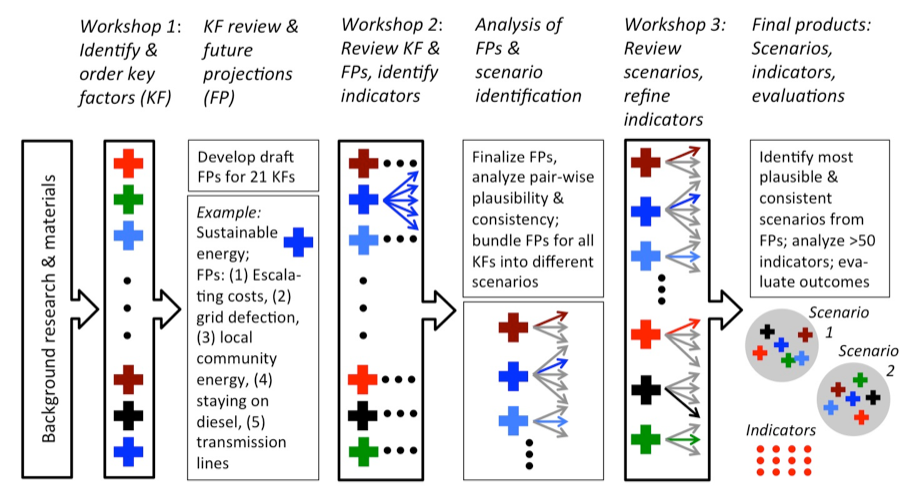Northern Alaska Scenarios Project

The results of the Northern Alaska Scenarios Project demonstrate the core values and key characteristics Arctic Alaska residents find significant to determine community resilience. Scenarios can also demonstrate what may be beyond our control. For all the possible futures in Arctic Alaska there are four key drivers that seem to be tipping points making the key factors produce desirable or undesirable results: (1) the boom bust cycle of economies, (2) government relations, (3) community relations, and (4) largely external forces. Each of these drivers has elements that can be monitored, controlled, managed, or affected by local governments, organizations, or community members. Each also has aspects that individuals, regions, and in some cases even national policy cannot directly affect. Understanding what is subject to democratic political debate and change, such as policies related to education, intersectional engagement, and housing is important for residents now and in the future to shape their communities. At the same time, citizen science such as observations of climate change, tracking demographics, and monitoring subsistence animals may help communities to better manage their own futures.
Our results add to the narrow range of studies where actual arctic residents are asked what makes them resilient rather than researchers interpreting for residents what they should value or what matters to sustainability. The key factors, future projections, and possible scenarios of the project can help guide community action and policy. Potential social and environmental hazards can be identified via indicator tracking over time, based on the knowledge and data collected from the workshops. A few next steps would be to expand the indicators being identified and collected, in particular filling gaps where community members recognize an important trend but there is not yet a monitoring process in place; to create a holistic community resilience dashboard specific to Arctic Alaska needs; and to engage other locations in Alaska in similar scenarios workshops to look for shared concerns and strategies across regions.
The project’s intellectual merit in advancing understanding within its own field and across other fields is significant. There was no principal discipline for this project, it was truly multi-disciplinary. The disciplines represented by the different CoPIs and students who participated, were affected by engaging in this process. For example, studies of Indigenous well-being don't generally include politics as a variable in terms of holistic health evaluations but our findings indicate this needs to be accounted for – fate control matters to well-being. In addition, one can look at the four successful PhD degrees that resulted, in part, from this project. They were in Cross-Cultural Studies, Communication, Geography, and Natural Resources Management. By participating in this project these students will carry the value of futures thinking, Indigenous and local knowledge, and interdisciplinarity into their own teaching and research in their own fields. Taken as a its own filed, our project contributed directly to Arctic Studies in several ways (1) except for the scenarios framework itself, the project was a co-production of knowledge with North Slope and Northwest Arctic Borough residents where the researchers worked on the key drivers of community health and sustainability, the projected futures of these drivers, and what a future might look like in their region, at the direction of our participants; (2) it tested the use of scenarios as a way to enhance social learning in rural, primarily Indigenous locations experiencing uncertain futures and found the process significant for participants and for research outcomes; (3) it confirmed and nuances a narrow range of evidence-based findings about community resilience in the Arctic.
The broader impacts of this work that benefit society and advance social outcomes are tied to the method that is discussed above. The two boroughs in Arctic Alaska must make decisions about an uncertain future with incomplete information. In a relatively short time, they need to gain the capacity to think ahead in rapidly changing complex environments and make crucial decisions to ensure the success of their planning efforts in the absence of complete information about what will happen in the coming decades. The survey data in the comprehensive report demonstrate critical elements to producing civic communication were present in our workshops’ outcomes: the production new knowledge, shared understanding of this knowledge, enhanced trust, and ultimately, a shift in perspective on community resilience. Such a process is vital in regions of the Arctic where decisions must be made under conditions of uncertainty and often among groups who may not fully trust one another or the knowledges presented. Ad hoc or spotty adaptation, which has often been the case in rural Alaska communities, has occurred at the same time as underlying efforts to create a long-term strategy and ongoing work towards a future with resilient communities. The latter work can be seen in the planning documents of both Barrow and Kotzebue. But this planning often does not capture the full spectrum of factors regional residents consider vital, and holistically interlinked, to healthy sustainable places to live. The main resilience concepts of adaptation and transformation are key in envisioning future states as well as integral in the strategic planning that is to occur after the scenarios development process is over.


